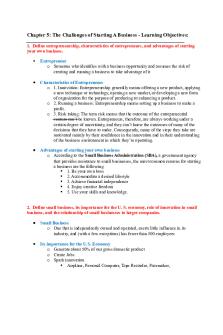Chapter 2 Lecture Notes 5 PDF

| Title | Chapter 2 Lecture Notes 5 |
|---|---|
| Course | Principles Of Macroeconomics |
| Institution | Brandman University |
| Pages | 2 |
| File Size | 69.6 KB |
| File Type | |
| Total Downloads | 5 |
| Total Views | 136 |
Summary
These notes are for the ECON 201 course taught by Professor Roger Lignugarus....
Description
Chapter 2 Trade Offs, Comparative Advantage, and the Market System
The two key groups in a modern economy Two key groups participate in the modern economy: •
Households consist of individuals who provide the factors of production: labor, capital, natural resources, and entrepreneurial ability. •
•
Households receive payments for these factors by selling them to firms in factor markets.
Firms supply goods and services to product markets; households buy these products from the firms.
The circular flow diagram Circular-flow diagram: A model that illustrates how participants in markets are linked. Households provide factors of production to firms. Firms provide goods and services to households. Firms pay money to households for the factors of production. Households pay money to firms for the goods and services.
A simplified model Like all economic models, the circular flow diagram is a simplified version of reality: •
No government
•
No financial system
•
No foreign buyers and sellers of goods
We will explore these sectors in later chapters.
The gains from free markets A free market is one with few government restrictions on how a good or service can be produced or sold, or on how a factor of production can be employed. Countries that come closest to the free market benchmark have been more successful than those with centrally planned economies in providing their people with rising living standards. This concept is not new: Adam Smith argued for free markets in his 1776 treatise, An Inquiry into the Nature and Causes of the Wealth of Nations.
The beauty of the machine mechanism It is not immediately obvious that markets will do better than centrally-planned systems for satisfying human desires. After all, individuals are acting only in their own rational self-interest. But markets with flexible prices allow the collective actions of households and firms to signal the relative worth of goods and services. In this way, the “invisible hand” allows individual responses to collectively end up satisfying the wants of consumers....
Similar Free PDFs

Chapter 2 Lecture Notes 5
- 2 Pages

Chapter 5 - Lecture notes 5
- 15 Pages

Chapter-5 - Lecture notes 5
- 6 Pages

Chapter 5 - Lecture notes 5
- 83 Pages

Chapter 5 - Lecture notes 5
- 4 Pages

Chapter 5 - Lecture notes 5
- 20 Pages

Chapter 5 - Lecture notes 5
- 4 Pages

Chapter 5 Lecture Notes
- 11 Pages

Chapter 5 - Lecture notes 5
- 7 Pages

Chapter 5 - Lecture notes 5
- 2 Pages

Chapter 5 - Lecture Notes
- 11 Pages

Chapter 5 - Lecture notes 5
- 3 Pages

Chapter 5 - Lecture notes 5
- 2 Pages

Chapter 5 - Lecture notes 5
- 6 Pages

Chapter 5 - Lecture notes 5
- 6 Pages

Lecture notes, lecture Chapter 2
- 11 Pages
Popular Institutions
- Tinajero National High School - Annex
- Politeknik Caltex Riau
- Yokohama City University
- SGT University
- University of Al-Qadisiyah
- Divine Word College of Vigan
- Techniek College Rotterdam
- Universidade de Santiago
- Universiti Teknologi MARA Cawangan Johor Kampus Pasir Gudang
- Poltekkes Kemenkes Yogyakarta
- Baguio City National High School
- Colegio san marcos
- preparatoria uno
- Centro de Bachillerato Tecnológico Industrial y de Servicios No. 107
- Dalian Maritime University
- Quang Trung Secondary School
- Colegio Tecnológico en Informática
- Corporación Regional de Educación Superior
- Grupo CEDVA
- Dar Al Uloom University
- Centro de Estudios Preuniversitarios de la Universidad Nacional de Ingeniería
- 上智大学
- Aakash International School, Nuna Majara
- San Felipe Neri Catholic School
- Kang Chiao International School - New Taipei City
- Misamis Occidental National High School
- Institución Educativa Escuela Normal Juan Ladrilleros
- Kolehiyo ng Pantukan
- Batanes State College
- Instituto Continental
- Sekolah Menengah Kejuruan Kesehatan Kaltara (Tarakan)
- Colegio de La Inmaculada Concepcion - Cebu